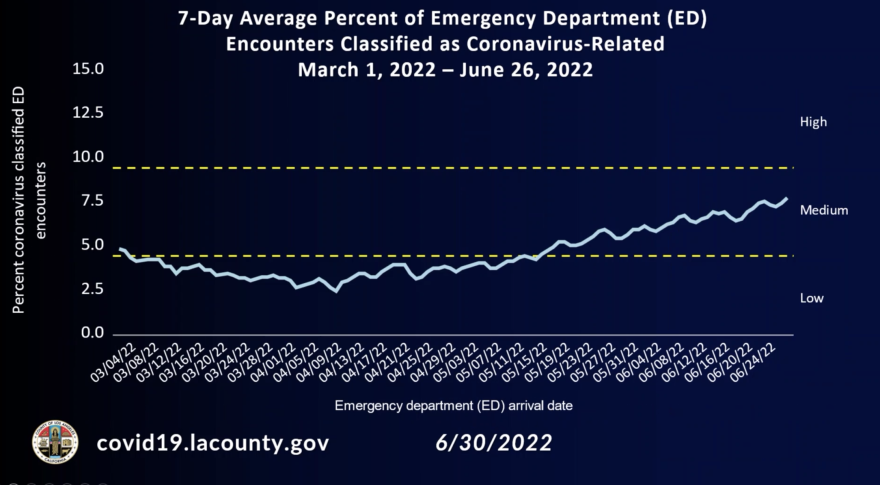Truth matters. Community matters. Your support makes both possible. LAist is one of the few places where news remains independent and free from political and corporate influence. Stand up for truth and for LAist. Make your year-end tax-deductible gift now.
ER Visits Are Up As COVID-19 Transmission Remains High In LA

Highly infectious omicron subvariants are infecting more people in Los Angeles County, keeping case counts high and sending more people to emergency rooms.
The number of hospital patients with COVID-19 topped 800 Thursday, while cases rose 17% from last week. Health officials reported more than 5,100 new coronavirus infections a day in the last week.
“With our rising case rates and the hospital readmission rates going up, we do have fresh concerns about the impact of COVID and it's more likely now that we might make it into that high community level sometime this summer,” County Public Health Director Barbara Ferrer said Thursday.
Ferrer said the case number is an undercount since it does not include positive over-the-counter tests that are generally not reported to the health department.
The seven-day average daily case rate has risen to 50 cases per 100,000 residents, while test positivity rose significantly to almost 14%. An average of seven deaths were reported each day last week.
More than 300 workplace outbreaks were reported in the last week, the highest number since the county began tracking them. Outbreaks at nursing homes have also increased.
Communities with high rates of poverty have the highest hospital admission rates, while the most affluent areas have the lowest.
“Those communities and families with fewer resources have been disproportionately hurt by this pandemic,” Ferrer said. “When COVID transmission is increasing as it is now, we have a collective responsibility to take steps that reduce risk and avoid transmitting the virus.”

Hospital admission rates are highest for Black residents and three times higher than the rates for Asian residents, who had the lowest of any race or ethnicity.
“Providers at both emergency rooms and urgent care centers have noted that this increased volume of COVID cases is coming at a time when they're also seeing unusually high numbers for the summer of patients with other respiratory illnesses, including flu and RSV, and when they're facing some staffing shortages associated with the high rates of COVID transmission which have led to more infections among health care workers,” Ferrer said.
If the upward trend of coronavirus-positive patients continues at the same pace, the county will move into the U.S. Centers for Disease Control and Prevention’s “high” virus activity category around July 19. That projection has fluctuated as hospitalization numbers have oscillated, though Ferrer said overall they continue to climb.
L.A. County is currently in the CDC’s “medium” level of COVID-19 activity. It will move into the “high” category if the average daily rate of new positive hospital admissions rises above 10 per 100,000 residents, or if the percentage of staffed hospital beds occupied by patients with COVID-19 tops 10%.
Both figures have been rising over the past several weeks, with the rate of new admissions reaching 8.1 per 100,000 residents as of Thursday. The portion of hospital beds in the county occupied by virus patients was 4.2% as of Thursday.
If the county enters the “high” category and stays there for two straight weeks, the health department will reimpose a public indoor mask mandate. That would include offices, schools, retail stores, factories and event venues.

Masks are already required in some places in L.A. County, including on public transit and at transportation hubs such as airports. A separate health order requires masks to be worn in high-risk places, including emergency shelters, doctors' offices, hospitals, homeless shelters, prisons, and long-term care facilities such as nursing homes.
Ferrer encouraged people to use rapid tests before gathering for fourth of July parties, keeping festivities outdoors and wearing masks while inside.
“These are pretty straightforward and pretty simple things. We can all do them, and we can do them fairly easily. And we just ask that everybody sort of double down and let's try to slow transmission here in L.A. County,” Ferrer said.







